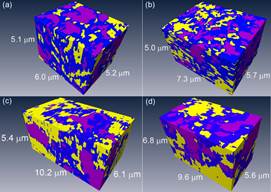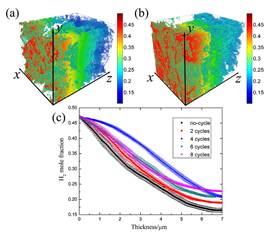| Three dimensional imaging of anode microstruction in solid oxide fuel cell |
| From: PublishDate:2017-06-16 Hits: |
In order to decrease the production cost of solid oxide fuel cell (SOFC), industrial grade NiO raw materials should be employed to prepare the Ni-YSZ anodes. However, industrial grade raw inevitably contain impurities, which can affect the microstructure and performance of Ni-YSZ anodes. Thus to understand impact of the content and type of impurities on performance of Ni-YSZ anodes, we applied hard X-ray microscopy at Beijing synchrotron to study the impact of impurities in NiO on the microstructure and performance of Ni-YSZ anodes. The research had been published on July 6th, 2016 in International Journal of Hydrogen Energy. Two different NiO powders (NiO-1 and NiO-2) were used to fabricate anode supports. These NiO powders contain different amounts of impurities, which were measured by inductively coupled plasma atomic emission spectroscopy (ICP-AES). The same NiO was used to fabricate the anode function layers (AFLs). The fabricated anodes were denoted anode-1 and anode-2. The study results show that during the sintering, the thick anode substrate influences the microstructural evolution of the thin anode functional layer, and over-sintering occurs in anode-2. Based on the study results and previous literatures, MgO impurity in the NiO-2 powder might be the main reason for decreasing the sintering temperature by 50 oC. The SOFC performance of the NiO-2-based electrode is significantly improved when decreasing its sintering temperature by 50 oC.
Fig.1 The two kinds of Ni-YSZ anode support and the same AFL were imaged by nano-CT at Beijing synchrotron and their three dimensional microstructions were obtained. The 3D structural parameters of the anode support and AFL, such as volume fraction of each phase, connectivity and three phase boundary, were quantitatively calculated based on 3D reconstructions. This can provide the key microstructional information for building the relationship between the microstruction and performance of the anode.
In addition, we used hard X-ray microscopy at Beijing synchrotron to image the 3D structural of Ni-YSZ anodes under thermal cycling. Based on the reconstructions the spatial distribution of the three phase boundary (TPB) length was obtained. Then the electrochemical reaction occurring at active-TPB was modeled by the Lattice Boltzmann Method for simulation of multi-component mass (H2 and H2O) transfer in porous anodes. The research had been published on September 30th, 2016 in Journal of Power Sources. The concentration polarization and the activation polarization were estimated respectively based on three reconstructions and the mole fractions of H2 and H2O. The results show that with increase of thermal cycles,the concentration polarization in anode decreases. This is caused by the H2 and H2O molar fraction variation in no-cycle anode was larger than that of the other four samples. The activation polarization and TPB length have an inverse relationship. The activation polarization increases with the decrease of TPB length. Based on three dimensional reconstructions we had built the model of gas transport and electrochemical reactions in anode, which can be used to better understand the relationship between electrode microstructure and performance of Ni-YSZ anodes and provide theoretical data for improving the performance of SOFC.
Fig.2 Distribution of H2 mole fraction in samples with different thermal cycles Article: 1. Yong Guan , Xiaolei Dong, Lei Zhang, Gang Liu, Zhiting Liang, Shan Chen, Liang Chen, Xiaobo Zhang, Ying Xiong, Haiqian Wang**, Yangchao Tian*. Effects of nickel oxide impurities on the microstructure and electrical properties of a nickel-yttria-stabilized zirconia anode. International Journal of Hydrogen Energy 41 (24) (2016), 10833–10843. 2. Pengfei Guo, Yong Guan*, Gang Liu, Zhiting Liang, Jianhong Liu, Xiaobo Zhang, Ying Xiong, Yangchao Tian**. Modeling of gas transport with electrochemical reaction in nickel-yttria-stabilized zirconia anode during thermal cycling by Lattice Boltzmann method. Journal of Power Sources 327 (2016) 127-134.
|
|
|
| Chinese
- Metal-free efficient photocatalyst for stable visible water splitting——Top ten major scientific progresses in China in 2015
- The nano-resolution imaging platform was awarded the first rate prize of Beijing Science and Technology in 2014
- Beamline 1W1 of BSRF started to runoperate in the couplingparasitic mode of BEPCII
- Synthesis of High Performance Polymer Materials for Field Effect-Transistors
- Surfactant molecular aggregates in green solvents
- GIXRD has played an important role in the characterization of organic thin-film transistors
Copyright © 2011 - 2012 Beijing Synchrotron Radiation Facility




